#Zoological Journal of the Linnean Society
Text
Muppet Fact #1048
According to a study published in the Zoological Journal of the Linnean Society, scientists have discovered a 270-million-year-old amphibamiform in Texas. The fossil was originally uncovered by the late Nicholas Hotton III. Due to the "cartoonishly wide-eyed face," the researchers have named the newly discovered species after Kermit the Frog, calling the proto-amphibian Kermitops gratus.
According to lead author Calvin So, they used Kermit's name in hopes of bridging the gap between the scientific community and the general public:
"Using the name Kermit has significant implications for how we can bridge the science that is done by paleontologists in museums to the general public. Because this animal is a distant relative of today’s amphibians, and Kermit is a modern-day amphibian icon, it was the perfect name for it.”

Sources:
Smithsonian. “Researchers Name Prehistoric Amphibian Ancestor Discovered in Smithsonian Collection After Kermit the Frog.” EurekAlert!, March 21, 2024. https://www.eurekalert.org/news-releases/1037759.
So, Calvin, Jason D. Pardo, and Arjan Mann. “A New Amphibamiform From the Early Permian of Texas Elucidates Patterns of Cranial Diversity Among Terrestrial Amphibamiforms.” Zoological Journal of the Linnean Society, March 21, 2024. https://doi.org/10.1093/zoolinnean/zlae012.
#muppet facts oc#jim henson#the muppets#muppets#muppet facts#fun facts#yes i have decided this is a Chicago style citation blog now i like Chicago style#Zoological Journal of the Linnean Society#Kermitops gratus#Smithsonian#calvin so#Jason D. Pardo#Arjan Mann
125 notes
·
View notes
Text

BIG DISCOVERY IN ENTOMOLOGY!
An extraordinary case of elytra loss in Coleoptera (Elateroidea: Lycidae): discovery and placement of the first anelytrous adult male beetle
Vinicius S Ferreira, Felipe Francisco Barbosa, Milada Bocakova, Alexey Solodovnikov
Insects are one of the few groups of animals that developed the ability of active flight. Such mobility allowed the group to successfully explore and thrive in nearly all kinds of ecological niches.
At the same time, during the evolutionary history of insects, due to high costs of wing development, flight was lost independently in many groups. In beetles, the reduction or complete loss of hind wings has been reported in multiple lineages, especially in several extreme paedomorphic and larviform females, mainly in Elateroidea, in which not only the hind wings but also the elytra are lost.
However, the complete absence of elytra in adult males was hitherto unknown, despite nearly half a million described species in Coleoptera.
In this study, we report the discovery of Xenomorphon baranowskii gen. et sp. nov., the first completely anelytrous and wingless adult male beetle, belonging to the family Lycidae (Coleoptera: Elateroidea). Xenomorphon baranowskii is illustrated, described, and provisionally placed in Calopterini, based on our morphology-based phylogenetic analyses.
We discuss the possible scenarios that could lead to such a rare event, when a beetle loses its elytra, and its evolutionary consequences.
Read the paper here:
extraordinary case of elytra loss in Coleoptera (Elateroidea: Lycidae): discovery and placement of the first anelytrous adult male beetle | Zoological Journal of the Linnean Society | Oxford Academic (oup.com)
2K notes
·
View notes
Text
Scientists have uncovered the fossilized skull of a 270-million-year-old ancient amphibian ancestor in the collection of the Smithsonian's National Museum of Natural History. In a paper published today, March 21, in the Zoological Journal of the Linnean Society, the team of researchers described the fossil as a new species of proto-amphibian, which they named Kermitops gratus in honor of the iconic muppet, Kermit the Frog.
According to Calvin So, a doctoral student at the George Washington University and the lead author on the new paper, naming the new creature after the beloved frog character, who was created by puppeteer Jim Henson in 1955, is an opportunity to get people excited about the discoveries scientists make using museum collections.
Continue Reading.
73 notes
·
View notes
Text
Riojavenatrix lacustris Isasmendi et al., 2024 (new genus and species)


(Shin and ankle bones [top, scale bars = 10 cm in A–O and 5 cm in P–T], and schematic skeletal by Scott Hartman [bottom], of Riojavenatrix lacustris, with preserved bones in fuchsia on the skeletal, from Isasmendi et al., 2024)
Meaning of name: Riojavenatrix = La Rioja huntress [in Latin]; lacustris = of lakes [in Latin]
Age: Early Cretaceous (probably Aptian)
Where found: Virgen del Villar-1, La Rioja, Spain
How much is known: Partial skeleton of one individual including some of the hindlimbs, fragments of the hips, and a partial back vertebra.
Notes: Riojavenatrix was a spinosaurid, a group of large theropods with specializations for feeding in aquatic habitats. It is one of many Early Cretaceous spinosaurids that have been found in the Iberian Peninsula, along with Vallibonavenatrix, Camarillasaurus, and Protathlitis, which are also from Spain, and Iberospinus from Portugal. Out of these, Riojavenatrix is likely youngest known spinosaurid from this time and region.
Reference: Isasmendi, E., E. Cuesta, I. Díaz-Martínez, J. Company, P. Sáez-Benito, L.I. Viera, A. Torices, and X. Pereda-Suberbiola. 2024. Increasing the theropod record of Europe: a new basal spinosaurid from the Enciso Group of the Cameros Basin (La Rioja, Spain). Evolutionary implications and palaeobiodiversity. Zoological Journal of the Linnean Society advance online publication. doi: 10.1093/zoolinnean/zlad193
92 notes
·
View notes
Text

[ The fossilized cervical vertebra and overlaying osteoderms of the new archosaur shown in a photograph, line drawing, and a computed tomography (CT) rendering model with the osteoderms and matrix removed (bottom). ]
"Researchers have described a new species of armored reptile that lived near the time of the first appearance of dinosaurs. With bony plates on its backbone, this archosaur fossil reveals that armor was a boomerang trait in the story of dinosaur and pterosaur evolution: the group's ancestors were armored, but this characteristic was lost and then independently re-evolved multiple times later among specialized dinosaurs like ankylosaurs, stegosaurs, and others. The study is published today in the Zoological Journal of the Linnean Society.
"We are just starting to understand that there were many dinosaur-like creatures across the planet well before dinosaurs evolved," said the study's lead author Sterling Nesbitt, associate professor of geosciences at Virginia Tech and a research associate in the American Museum of Natural History's Division of Paleontology. "Dinosaurs were latecomers to the Triassic reptile party. They showed up well after many dinosaur-looking reptiles were established across our planet."
Archosaurs are reptiles that are divided into two major branches: the bird-line, which includes pterosaurs and dinosaurs, including living dinosaurs (birds); and the crocodilian line, including crocodiles, alligators, caimans, and gharials. The newly described archosaur species, named Mambachiton fiandohana, is the earliest diverging member of the bird line of archosaur evolution."
Read more: "New archosaur species shows that precursor of dinosaurs and pterosaurs was armored"
#palaeoblr#Palaeontology#Paleontology#Mambachiton fiandohana#Mambachiton#Article#Information#Prehistoric#Extinct#Mesozoic#Triassic#Fossil
81 notes
·
View notes
Text
https://www.miamiherald.com/news/nation-world/world/article279745424.html
Pregnant ‘dwarf’-like creature found on tree in Uganda is ‘cryptic’ new species
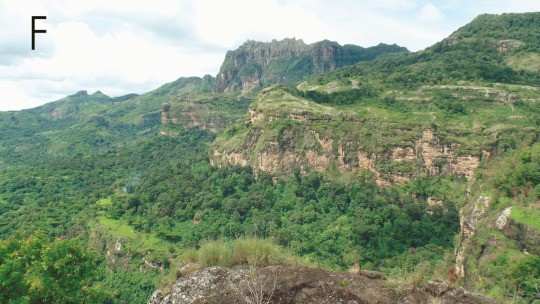
Nestled into the woodlands of Uganda sat a “dwarf”-like creature. The pregnant animal waited out the night on a tree trunk —or tried to.
Passing scientists spotted the pregnant animal — and discovered a “cryptic” new species.
Researchers ventured into the woodlands of the Karamoja region of the central African country several times in 2015, according to a study published Sept. 23 in the Zoological Journal of the Linnean Society.
During their fieldwork, researchers found seven lizards perched on tree trunks, the study said. Intrigued, they took a closer look at the lizards and discovered a new species: Lygodactylus karamoja, or the Karamoja dwarf gecko.
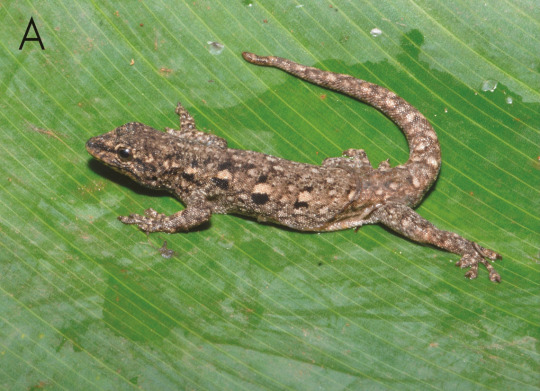
The Karamoja dwarf gecko is considered “large,” reaching about 3 inches in size, the study said. It has a “slender” body, “rounded” snout and several “chevrons” on its throat.
Underneath, the gecko’s belly and groin are various shades of yellow, photos show. A pattern of U and V-shaped stripes decorates its throat.

The new species lives in woodland habitats of “mid-elevation savannahs” in the Karamoja region, the study said. Researchers named the new species after this region, “which is occupied by the Karamojong people.”

The new species was identified by its size, color pattern, scale pattern and other “minor” physical features, the study said. DNA analysis found the new species had between about 6% and about 16% genetic divergence from other dwarf geckos.
The research team included Javier Lobón-Rovira, Aaron Bauer, Pedro Vaz Pinto, Jean-Francois Trape, Werner Conradie, Chifundera Kusamba, Timóteo Júlio, Garin Cael, Edward Stanley, Daniel Hughes, Mathias Behangana, Franck Masudi, Olivier Pauwels and Eli Greenbaum.
Researchers also discovered four more new species of dwarf geckos: a “large” mountain-dwelling gecko, a gecko with a “leopard-like” pattern, a gecko from a “unique” habitat and a “large” forest-dwelling gecko.
4 notes
·
View notes
Text
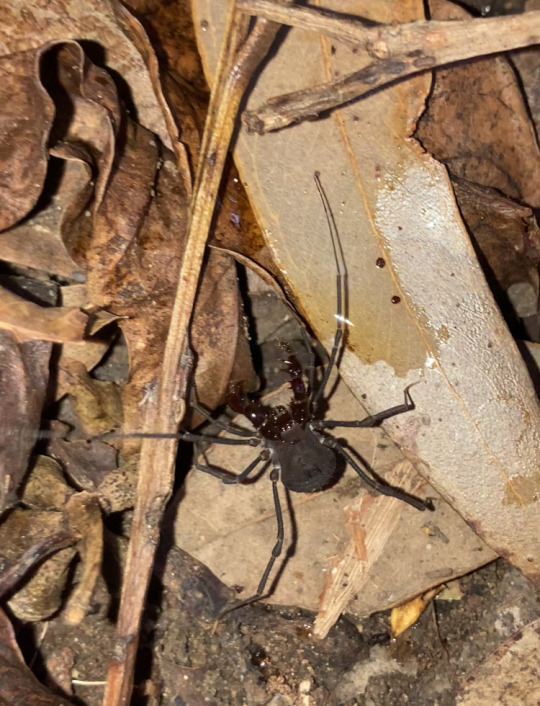
the first creature will be the man who started it all, Equitius formidabilis. this little guy is a harvestman, related to other arachnids you might have heard of, like spiders, scorpions, mites, and ticks, as well as some you might not have heard of, like vinegaroons, tailless whip scorpions and solfugids. this guy in particular doesn't fit the typical look of a harvestman, and is in the family Triaenonychidae, with a couple glaring features
first - those huge claws he's waving at me in a threat display are his pedipalps - structures homologous to scorpion claws and those little arms spiders have beside their fangs. these big raptorial (grabby) palps, much like those of other harvestmen in the suborder Laniatores, are used for grabbing prey and fighting other harvestmen, although much of the study on the use of the pedipalps in Laniatores has been done in another family, the Gonyleptidae. they're also heavily armoured, and often curl up into a ball and play dead when resting or disturbed.

harvestmen in the genus equitius are found all along eastern australia, and despite their very spiny and scary appearance, these guys are completely harmless, lacking venom entirely, unlike their scorpion, spider, and (controversially) tick cousins. among other features, they're characterised by a large spine poking up between their eyes.
this guy in particular was first described by glenn hunt in 1985, which is shockingly late considering there's one under every second rock in most rainforest gulleys - hunt himself noted that members of the genus equitius were among the most common arachnids to find under debris in eastern australian rainforests and wet sclerophyll.


leaving off with a cute, spiky baby nestling up to a parent, let's talk about parental care. despite past disagreement in the literature as to whether parental care in Triaenonychidae is paternal or maternal, we do know that these guys invest a lot into keeping their eggs safe, by hiding and guarding them. little guys
source: dude trust me
Machado, G. (2007). MATERNAL OR PATERNAL EGG GUARDING? REVISITING PARENTAL CARE IN TRIAENONYCHID HARVESTMEN (OPILIONES). The Journal of Arachnology, 35(1), 202–204. https://doi.org/10.1636/SH06-14.1
Machado, G., & Raimundo, R. L. G. (2001). Parental investment and the evolution of subsocial behaviour in harvestmen (Arachnida Opiliones). Ethology Ecology & Evolution, 13(2), 133–150. https://doi.org/10.1080/08927014.2001.9522780
Wolff, J. O., Schönhofer, A. L., Martens, J., Wijnhoven, H., Taylor, C. K., & Gorb, S. N. (2016). The evolution of pedipalps and glandular hairs as predatory devices in harvestmen (Arachnida, Opiliones). Zoological Journal of the Linnean Society, 177(3), 558–601. https://doi.org/10.1111/zoj.12375
#invertebrates#arthropods#arachnida#opiliones#laniatores#triaenonychdiae#equitius#guy who is actually using tumblr for pseudoblogging
6 notes
·
View notes
Text
Newly discovered Amazonian fish are already threatened

Two new colorful species of fish have been found in Brazil's Amazon Basin -- and they are already at risk of disappearing due to extinction.
The fish belong to a subfamily called South American darters. The discovery brings the known number of darter species to five.
One species, Poecilocharax callipterus, is distinguished by its long, striking red-orange fins and a dark spot at the base of its tail.
The other new species, Poecilocharax rhizophilus is the most miniature darter ever identified. This tiny fish only measures about three-quarter inch (2 centimeters) in length as a mature adult. It's bright yellow with a black stripe along its flanks and has a silver to white belly.
A study describing the two new species, and threats to their environment, published Monday in the Zoological Journal of the Linnean Society.
Deforestation and other human impacts are pushing the Amazon rainforest toward a tipping point that would turn the biologically rich, diverse ecosystem into a grassy savanna -- and those stressors can be felt beneath the water's surface as well as above it.
Study author Murilo Pastana, a postdoctoral research fellow at the Smithsonian National Museum of Natural History in Washington, and his colleagues saw evidence of this during their expeditions between 2015 and 2016.
"It was exciting to find new species," Pastana said. "But in the field, we saw the forest on fire, logging trucks carrying out huge trees, and cleared patches turned into cattle pasture. This made us feel a lot of urgency to document these species and publish this paper as quickly as possible."
Continue reading.
@mindblowingscience
#brazil#politics#science#biology#environmentalism#brazilian politics#mod nise da silveira#image description in alt
13 notes
·
View notes
Photo
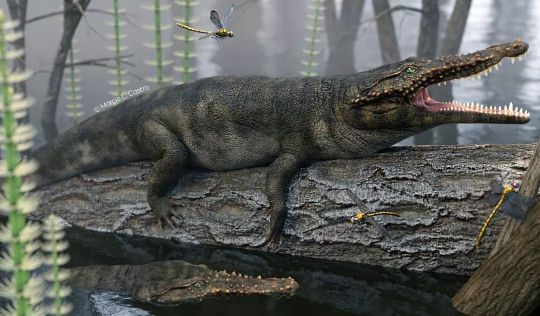
Foi publicado na última sexta-feira (01/07), no prestigiado periódico britânico Zoological Journal of the Linnean Society, um novo artigo. O estudo aborda a redescrição do arcossauriforme Proterochampsa nodosa, animal predador do Triássico Superior do Rio Grande do Sul. Os proterocampsídeos eram répteis predadores de médio porte que viveram durante o período Triássico (há cerca de 230 milhões de anos). Até agora, fósseis desses animais foram encontrados, exclusivamente, em rochas do Triássico da Argentina e do Rio Grande do Sul. Várias espécies desse grupo apresentam características muito semelhantes aos jacarés e crocodilos de hoje em dia, como um focinho alongado, crânio largo e achatado, grandes dentes cônicos e narinas dorsais na ponta do focinho. Tais semelhanças levam os paleontólogos a acreditar que esses animais, provavelmente, teriam uma dieta e hábito de vida similar. Mas, apesar disso, os proterocampsídeos pertenciam a uma linhagem completamente separada dos crocodilianos e seus descendentes, que também já viviam na mesma época. . . #paleoart #arcosauria #zbrush #blender3d #b3d #fossils #reptiles #marciolcastro https://www.instagram.com/p/Cfu0r5CLU5Z/?igshid=NGJjMDIxMWI=
4 notes
·
View notes
Text
Researchers name prehistoric amphibian ancestor discovered in Smithsonian collection after Kermit the Frog.
Scientists have uncovered the fossilized skull of a 270-million-year-old ancient amphibian ancestor in the collection of the Smithsonian’s National Museum of Natural History. In a paper published today, March 21, in the Zoological Journal of the Linnean Society, the team of researchers described the fossil as a new species of proto-amphibian, which they named Kermitops gratus in honor of the…

View On WordPress
0 notes
Text
Un nouveau coléoptère possède un pénis en forme de décapsuleur et porte donc le nom d'une bière
See on Scoop.it - EntomoNews
S'il est une chose utile pour distinguer les insectes, c'est bien leurs organes génitaux. Ces derniers évoluent pour être différents d'une espèce à l'autre, c'est pourquoi c'est l'une des premières choses que les entomologistes recherchent. Or, une équipe de l'université de Copenhague, au Danemark, a découvert six nouvelles espèces de coléoptères en Amérique du Sud, dont l'une possède un organe sexuel à la forme particulièremen
Guru Med | 15 Nov 2023
L’étude publiée dans le Zoological Journal of the Linnean Society : Phylogeny-based taxonomic revision and niche modelling of the rove beetle genus Loncovilius Germain, 1903 (Coleoptera: Staphylinidae: Staphylininae) et présentée sur le site de l’Université de Copenhague : New beetle species has bottle-opener shaped genitalia: Now that calls for a Carlsberg!
Image d’entête : la nouvelle espèce, Loncovilius carlsbergi, dont les organes génitaux mâles ne laissent pas indifférents. (Université de Copenhague)
0 notes
Text
I paleontologi scoprono una nuova specie di dinosauro sauropode in Spagna
Ricostruzione grafica di Garumbatitan morellensis.
Un articolo pubblicato oggi sulla rivista Zoological Journal of the Linnean Society annuncia la scoperta del Garumbatitan morellensis, una specie di dinosauro somfospondilo precedentemente non documentata.
Il Garumbatitan morellensis visse nell’attuale penisola iberica durante il primo Cretaceo, circa 122 milioni di anni fa.
Questo dinosauro…

View On WordPress
0 notes
Text
A team of Australian scientists led by Australian Museum (AM) and University of New South Wales (UNSW) paleontologist Dr. Matthew McCurry have formally named and described a fossil spider, Megamonodontium mccluskyi, which is between 11–16 million years old. The findings on this new genus of spider have now been published in the Zoological Journal of the Linnean Society.
Found at McGraths Flat, NSW, a fossil site known for its iron-rich rock called "goethite," the new genus of spider is the first ever spider fossil of the Barychelidae family to be found. Similar to the living genus, Monodontium (a brushed trapdoor spider) but five times larger (carapace length, ~10 mm; entire spider, ~50mm from toe to toe), the spider was named after Dr. Simon McClusky who found the specimen. A geospatial scientist based in Canberra, McClusky volunteers his time helping on palaeontological excavations.
Dr. McCurry said that there have been very few fossil spiders found in Australia which makes the discovery very significant.
"Only four spider fossils have ever been found throughout the whole continent, which has made it difficult for scientists to understand their evolutionary history. That is why this discovery is so significant, it reveals new information about the extinction of spiders and fills a gap in our understanding of the past."
Continue Reading
162 notes
·
View notes
Text
Garumbatitan morellensis Mocho et al., 2023 (new genus and species)
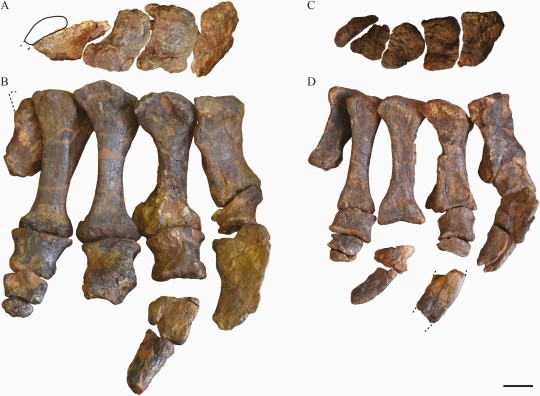
(Right hind feet of Garumbatitan morellensis [scale bar = 50 mm], from Mocho et al., 2023)
Meaning of name: Garumbatitan = Mola de la Garumba titan [in Greek]; morellensis = from the Arcillas de Morella Formation and the town of Morella
Age: Early Cretaceous (Barremian)
Where found: Arcillas de Morella Formation, Valencian Community, Spain
How much is known: Partial skeletons of three individuals, the most complete of which includes much of the vertebral column and hindlimbs.
Notes: Garumbatitan was a macronarian sauropod, making it a close relative of brachiosaurids and titanosaurs. It appears to have been more closely related to titanosaurs than to brachiosaurids. The hind foot of Garumbatitan is exceptionally completely known and exhibits a unique combination of features among sauropods, including the loss of one of the tarsals (ankle bones), the middle three metatarsals (long bones of the foot) being especially slender, and the claw on its third toe being reduced in size.
Reference: Mocho, P., F. Escaso, J.M. Gasulla, À. Galobart, B. Poza, A. Santos-Cubedo, J.L. Sanz, and F. Ortega. 2023. New sauropod dinosaur from the Lower Cretaceous of Morella (Spain) provides new insights on the evolutionary history of Iberian somphospondylan titanosauriforms. Zoological Journal of the Linnean Society advance online publication. doi: 10.1093/zoolinnean/zlad124
76 notes
·
View notes
Text

[ Life reconstruction of Pampaphoneus biccai by Márcio Castro. ]
"Dinosaurs have quite the reputation for being the largest, fiercest predators in life's history. Yet, 40 million years before dinosaurs ruled, Pampaphoneus biccai dominated South America as the biggest and most bloodthirsty meat eater of its time.
In a new study published in the Zoological Journal of the Linnean Society, an international team of researchers reveal the astounding discovery of a 265-million-year-old, exquisitely preserved fossil species, Pampaphoneus biccai, found in the rural area of São Gabriel, Southern Brazil.
The stunning fossil includes a complete skull and some skeletal bones, such as ribs and arm bones. Pampaphoneus, which belongs to the early therapsid clade called dinocephalians, lived just before the largest extinction event in the history of Earth that eliminated 86% of all animal species worldwide.
Before the extinction event, dinocephalians were one of the major groups of large terrestrial animals that thrived on land. They were medium to large-sized creatures with both carnivorous and herbivorous representatives. Dinocephalians had thick cranial bones, which led to the group's name which translates to "terrible head" in Greek. While well-known in South Africa and Russia, these animals are rare in other parts of the world. Pampaphoneus biccai is the only known species in Brazil."
Read more: "265-million-year-old fossil reveals oldest, largest predator in South America, long before the rise of dinosaurs" from Harvard University.
#palaeoblr#Palaeontology#Paleontology#Pampaphoneus#Pampaphoneus biccai#Dinocephalian#Permian#Paleozoic#Article#Information#Art
18 notes
·
View notes
Text
0 notes